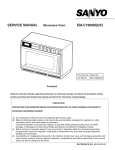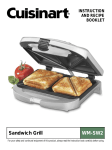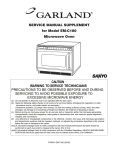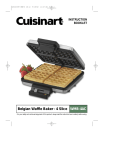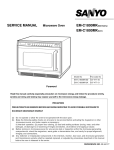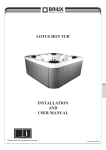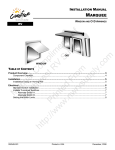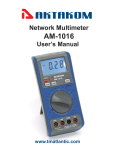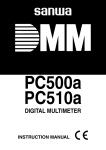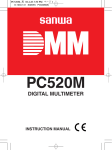Download SERVICE MANUAL Microwave Oven EM
Transcript
SERVICE MANUAL Microwave Oven EM-C1900 (GERMANY) Pro.Code No. 437 623 01 Foreword Model No. EM-C1900SD Read this manual carefully, especially precaution on microwave energy, and follow the procedure strictly,careless servicing and testing may expose yourself to the microwave energy leakage. PRECAUTIONS PRECAUTIONS TO BE OBSERVED BEFORE AND DURING SERVICING TO AVOID POSSIBLE EXPOSURE TO EXCESSIVE MICROWAVE ENERGY (a) Do not operate or allow the oven to be operated with the door open. (b) Make the following safety checks on all ovens to be serviced before activating the magnetron or other microwave source, and make repairs as necessary: (1)Interlock operation, (2) proper door closing, (3) seal and sealing surfaces (arcing, wear, and other damage), (4) damage to or loosening of hinges and latches, (5) evidence of dropping or abuse. (c) Before turning on microwave power for any service test or inspection within the microwave generating compartments, check the magnetron, wave guide or transmission line, and cavity for proper alignment, integrity, and connections. (d) Any defective or misadjusted components in the interlock, monitor, door seal, and microwave generation and transmission systems shall be repaired replaced, or adjusted by procedures described in this manual before the oven is released to the owner. REFERENCE NO. SM-6410022-00 - TABLE OF CONTENTS Adjustment Procedures ............................................. 1 Specifications ............................................................ 2 Power output Measurement ....................................... 2 Precautions and Repair Service Tips .......................... 2 Circuit Diagram .......................................................... 3 Test Procedures and Troubleshooting ................... 4-10 Disassembly Instructions .................................... 11-14 Exploded View and Parts List ............................. 15-22 Overall Circuit Diagram......................................23-24 Control Circuit Board ................................................ 25 (6) Make sure the microwave energy leakage should be no greater than 5 mW/cm2 to allow to measurement uncertainty when measured with a detector. (All service adjustments must be made for minimum microwave energy leakage readings.) CAUTION MICROWAVE RADIATION PERSONNEL SHOULD NOT BE EXPOSED TO THE MICROWAVE ENERGY WHICH MAY RADIATE FROM THE MAGNETRON OR OTHER MICROWAVE GENE RATING DEVICE IF IT IS IMPROPERLY USE OR CONNECTED. ALL INPUT MICROWAVE CONNECTIONS, WAVEGUIDE, FLANGES, AND GASKETS MUST BE SECURE. NEVER OPERATE THE DEVICE WITHOUT A MICROWAVE ENERGY ABSORBING LOAD ATTACHED. NEVER LOOK INTO AN OPEN WAVE GUIDE OR ANTENNA WHILE THE DEVICE IS ENERGIZED. NOTE: If the interlock monitor circuit operates and at the same time the fuse blows with the door opened, be sure to replace the relay circuit board because relay 3 and 4 on the control circuit board, the door sensing switch and the electric circuit related on the door sensing switch, which act as Secondary Interlock switch. 1. ADJUSTMENT PROCEDURES Lever stopper NC NO C TO AVOID POSSIBLE EXPOSURE TO MICROWAVE ENERGY LEAKAGE, THE FOLLOWING ADJUSTMENTS OF THE INTERLOCK SWITCHES SHOULD BE MADE ONLY BYAUTHORIZED SERVICE PERSONNEL. PRIMARY INTERLOCK SWITCH, INTERLOCK MONITOR SWITCH AND DOOR SENSING SWITCH ADJUSTMENT Interlock monitor switch Latch lever (Figure 1) NO NC (1) Loosen 2 screws securing the lever stopper. (2) Adjust the lever stopper position so that it is pushed up and pull backward until there is about zero gap between the latch lever and the switch body on the door primary interlock switch and the at the same time there is about zero gap between latch lever and the switch body on the door sensing switch when the door latch is securely locked. (3) Tighten the lever stopper screws securely. (4) Make sure the interlock monitor switch closes after the primary interlock switch opens the door is opened very slowly, according to "CHECKOUT PROCEDURE FOR SWITCHES" on page 6. (5) Make sure the interlock monitor switch opens before the primary interlock switch closes when the door is closed very slowly, according to "CHECKOUT PROCEDURE FOR SWITCHES" on page 6. Primary Interlock switch C Latch lever NO NC C Door sensing switch Screws -1- Figure 1 (1) Before the power is applied. (a) Open and close door several times to make sure the door interlock switch and interlock monitor switch operation properly. (Listen for the clicking sound from switches.) Make sure the interlock monitor switch is closed after the latch interlock switch is open when the door is opened. (See pages 1 and 6) (b) Make sure the perforated screen and the choke dielectric of the door are correctly mounted. (2) After the power is applied. (a) Open and close the door to see if the interlock mechanism operates properly. (b) Check microwave energy leakage with a leakage detector and confirm the energy leakage is below 5mW/cm². (3) Do not operate the unit until it is completely repaired if any of the following conditions exists. (a) Door is not closed firmly against the cavity front. (b) The hinge is broken. (c) The choke dielectric or the door seal is damaged. (d) The door is bent or warped, or there is any other visible damage to the oven that may cause microwave energy leakage. Note: Always keep the seal clean. (e) Make sure that there are no defective parts in the interlock mechanism. (f) Make sure that there are no defective parts in the microwave generating and transmission assembly. (especially wave guide) (4) Following items should be checked after the unit is repaired. (a) The interlock monitor switch is connected correctly and firmly. (b) The magnetron gasket on the magnetron is properly positioned. (c) Wave guide and oven cavity are intact. (No leakage of microwave energy). (d) The door can be properly closed and the safety switches work properly. (e) The oven must be stopped when the door is opened or the time is up. The oven must not be operated with any of the above components removed or bypassed. 2.SPECIFICATIONS Microwave output ................. 1,900W to 190W Frequency ............................ 2,450MHz Power supply ....................... 220-230V, 50Hz Rated current ....................... 12.8 A Safety Device ....................... Thermal limitter (Magnetron) 150°C Open Thermal limitter (Duct)..........140°C Open Thermistor (Magnetron) .... ...165°C Open Thermistor(Duct) .............. ...120°C Open Fuse (Cartridge Type) ...... ...250V 10A x2 Micro switch, Relay Primary interlock switch Interlock monitor switch Door sensing switch and Relay RL-3 and 4 Max. input time.......Electronic Digital,up to Manual 10min. Memory 6min.(power level 10-6) 30min.(power level 5-0) Overall Dimensions ......... 422(W)x540(D)x335(H) mm Oven cavity size .............. 330(W)x330(D)x230(H) mm Effective Capacity of Oven Cavity..........19.1 liters Net weight ............................ ...............32Kg 3. POWER OUTPUT MEASUREMENT (1) Prepare 1000±5g tap water. (2) Adjust water temperature to 10±2°C. (3) Pour water into a container made of borosilicate Glass, 190mm outer diameter cylinder, maximum 3mm thickness. Note : Use the container kept on the room temperature. (4) Place the container on the center of oven cavity. (5) Set the heating time for 26 seconds and rating full power and then start oven. (6) Take the container out immediately when heating time is up. (7) Stir water for making even water temperature in the container. (8) Measure water temperature. Water temperature rise shall be 8 to 12°C. 4. PRECAUTIONS AND REPAIR SERVICE TIPS PRELIMINARY HINT FOR LAMP CHANGE Before removing the bulb access panel, pull out the main plug. Change the faulty bulb and secure the bulb access panel. Plug the cord back in and check operation. A. SINCE NEARLY 4,000 VOLTS EXISTS IN SOME CIRCUITS OF THIS MICROWAVE OVEN, REPAIRS SHOULD BE CARRIED OUT WITH GREAT CARE. B. TO AVOID POSSIBLE EXPOSURE TO MICROWAVE ENERGY LEAKAGE, THE FOLLOWING PRECAUTIONS MUST BE TAKEN BEFORE SERVICING. -2- FUNCTION OF KEY SWITCHES Please read each function key below. Power Key Memory Key Start Key Time Key Clear Key 6. TEST PROCEDURES AND TROUBLESHOOTING CAUTION -DISCONNECT THE POWER SUPPLY CORD FROM THE WALL OUTLET WHENEVER REMOVING THE CABINET FROM THE UNIT. PROCEED WITH TESTS ONLY AFTER DISCHARGING THE HIGH VOLTAGE CAPACITOR AND REMOVING THE LEAD WIRES ON THE PRIMARY WINDING OF THE HIGH VOLTAGE TRANSFORMER. (SEE FIGURE 2) Primary Winding Filament windings Figure 2 A. TEST PROCEDURES COMPONENT MAGNETRON Secondary windings CHECKOUT PROCEDURE RESULT 1) Check for resistance: Across the filament terminal of the magnetron with an ohm meter on Rx1 scale. Normal reading: Less than 1 ohm. Figure3 2) Check for resistance: Between each filament terminal of the magnetron and the chassis ground with an ohm meter on highest scale. Figure 4 -4- Normal reading: Infinite ohms. COMPONENT HIGH-VOLTAGE TRANSFORMER CHECKOUT PROCEDURE RESULT 1) Measure the resistance: With an ohm meter on Rx1 scale. a. Primary winding; b. Filament winding; c. Secondary winding; 2) Measure the resistance: With an ohm meter on highest scale. a. Primary winding to ground; b. Filament winding to ground; Figure 5 HIGH-VOLTAGE CAPACITOR Including bleeder resistor Measure the resistance: Across two terminals with an ohm meter on highest scale. Normal reading: a. Approximately 1.0 ohms. b. Less than 1 ohm. c. Approximately 60 ohms. Normal reading: a. Infinite ohms. b. Infinite ohms. Note: Remove varnish of measured point. Normal reading: Momentary indicates several ohms, and gradually to 10 meg-ohms. Abnormal reading: Indicates continuity or 10 meg-ohms from the beginning. Figure 6 HIGH-VOLTAGE DIODE Measure the resistance: Across two terminals with an ohm meter on highest scale. Figure 7 FUSE DIODE Measure the resistance: Across two terminals with an ohm meter on highest scale. Normal reading: Indicate about the middle position in one direct ( forward ) and infinite ohms in the reverse direction, using meter with a 9-volts battery. NOTE - Some digital meter may show over even in a forward direction because low measuring voltage of meter does not allow the meter to pass through the high voltage diode. Abnormal reading: Indicates continuity or infinite ohms in both directions. Normal reading: Indicate infinite ohms in both directions. Abnormal reading: Indicates continuity in both directions or continuity in one direction and infinite ohms in reversed direction. Figure 8 -5- COMPONENT TOUCH KEY BOARD CHECKOUT PROCEDURE RESULT Measure the resistance between terminals of FPC connector after removing it from S101.(Figure 9) NOTE - When reconnecting the FPC connector, make sure the holes on the connector are properly inserted in hook of the plastic fastener in S101. MATRIX CIRCUIT FOR TOUCH KEY BOARD FPC CONNECTOR When Resistance touched Less than Value 1K ohms A4 A5 A6 2 1 0 5 4 3 7 6 8 When checking “ ”key, connect ohm-meter as illustration below. A1 A2 A3 A4 A5 A6 A7 A8 A9 9 A7 A8 A9 When not touched More than 1M ohms +10 A1 A2 A3 TERMINAL OF FPC CONNECTOR Figure 9 CHECKOUT PROCEDURE FOR SWITCHES Disconnect the lead wires from the switches and check for the continuity of the switches, connecting an ohm-meter to its terminals. SWITCHES (See Figure 1 on page 1) CHECKOUT PROCEDURE PRIMARY INTERLOCK Terminals “COM” and “NO” DOOR OPEN DOOR CLOSE 0 0 0 0 DOOR SENSING INTERLOCK MONITOR Terminals “COM” and “NC” CAUTION: After checking the switches, make sure that the interlock monitor switch is properly connected according to the “CIRCUIT DIAGRAM” on page 3. -6- Primary winding WARNING: When removing the cabinet, you must disconnect the power supply cord from the wall outlet for your safety. Only the checkout procedure below needs the power supply on. TAKE GREAT CARE to avoid possible shock. For your safety, proceed with the test only after removing the wire leads from the primary winding of the high voltage transformer. Primary winding Lower Figure 10 Upper COMPONENT CHECKOUT PROCEDURE RESULT POWER P.C.B Check each voltage at connector S104 and S105 after removing each connector (female) from power circuit board. Pin No.3 (Ground) and 4,5,1,2 at S105. Pin No.1 and 2 at S104. CAUTION: Proceed with the test only after removing the wire leads from the primary winding of high voltage transformer for your safety. Test procedures: a) Make sure that the power supply cord is not plugged in. b) Remove the connector S104 and S105 from the power circuit board. c) Plug the power supply cord. d) And then, measure each voltage. Measure the voltage: Between test points TP-1, TP-2 ,TP-3 and ground. (See Figure 16 on page 25) CONTROL P.C.B Note - Proceed with the check of the control P.C.B to see if any one of the measured values is different from the specified values. -7- Normal reading: Connection Pin No. S105 #3 to #4 #3 to #5 #3 to #2 #3 to #1 S104 #1 to #2 Test point TP TP-1 TP-2 TP-3 TP-4 Voltage DC 12V DC 16V DC 30V DC 35V AC 2.4V Voltage DC - 5V DC - 12V DC - 16V DC - 35V B. TROUBLESHOOTING CONDITION TROUBLE Power with normal voltage is applied. Place a cup of water inside microwave oven “ ”,“ 1 ”,“ 0 ”,“ 0 ” ” keys and “ are touched. Fuse(10A) blows off immediately No display cooking time Cooking operation will not start CHECK RESULT REMEDY Step down Transformer Shorted Replace H.V Capacitor Shorted Replace H.V Diode Shorted Replace Connection of FPC from Touch key board Incorrect Reconnect Power circuit board (See page 7) Voltage incorrect Replace Touch key board (See page 6) Resistance incorrect Replace Control circuit board (See page 7) Voltage incorrect Replace Door sensing switch (See page 6) No continuty Replace Interlock switch (See page 6) No continuty Replace Control circuit board (See pages 7 & 25) Voltage incorrect Replace * Note:Oven will not accept settings of 60 through to 99 seconds. TIME must be entered as 1 minute and 39 seconds for 99 seconds. -8- CONDITION TROUBLE CHECK RESULT Low microwave output Magnetron Uneven heating Rotation of top or bottom antenna REMEDY Poor oscillation Replace Gear motor rotation has stopped. Repair or replace C. ERROR INDICATION The Display will show an error indication for self diagnosis as follows. "E" means that a service technician is required. "U" means that user can correct the operation. Display E-21 Trouble Thermistor (on duct) senses a temperature of 120°C or higher. Other Symptom Oven stops heating. Buzzer continuously beeps. Blower motor will stop immediately. Solution Check and remove the cause of the cavity fire or abnormal overheating. This error function will be cancelled when the power cord is unplugged. E-31 Thermistor (on Magnetron or Duct) is shorted. Oven stops heating. Buzzer does not beep. Blower motor will stop immediately. Check for short-circuit of thermistor itself or wire insulation of thermistor. This error function be cancelled when the power cord is unplugged. E-32 Thermistor (on Magnetron or Duct) is opened. Oven stops heating. Buzzer does not beep. Blower motor is operated. Check for open-circuit of thermistor itself or improper connection of wire socket of thermistor. This error function be cancelled when the CLEAR key is touched. U-10 Thermistor (on Magnetron) senses a temperature of 225°C or higher. Oven stops heating. Buzzer continuously beeps. Blower motor will stop immediately. Check and remove cause of abnormal overheating (such as operation with no food). This error function will be cancelled when the CLEAR key is touched. The key for “ ” is not touched within 1 minute after the door is opened or closed. (Remark:The purpose of this This error function will be cancelled when the function is to avoid accidental door is opened and closed. operation while the user is not attempting to operate the oven.) U-50 -9- 1 2 3 Thermistor Chart Duct Magnetron 4 Resistance (K ohm) Thermistor connector 8000 7000 6000 5000 4000 3000 2000 1000 0 0 10 20 30 40 50 60 Temperature (°C) “HINT” PROCEDURE FOR DETERMING WHETHER THE UPPER MAGNETRON CIRCUIT OR LOWER MAGNETRON CIRCUIT IS DEFECTIVE. SYMPTOM:One magnetron does not work giving less than normal heat. Caution: Make sure that cabinet (outer wrap) and rear plate are not removed from the oven for your safety. 1.Operate oven as follows. 1)Place a cup of water in the oven 2)Close the door. 3)Touch “CLEAR”, “TIME”, “5”, “0” and “START” keys to operate the oven for 50 seconds with full power level. 2. Determine if the Exhaust air is warm in the following positions.. 1)Put your hand near the exhaust duct outside of the rear plate to feel the exhaust (Never remove the cabinet and rear plate from the oven for your safety when you put your hand near exhausting duct.) 2)If air from the upper position of the duct is not warm,the upper magnetron circuit is defective. If air from the lower position of the duct is not warm,the lower magnetron circuit is defective. Cabinet(outer wrap) Rear Plate Upper position Rear Plate Lower position Exhaust Duct Figure 11 The H.V Transformer for operating the lower Magnetron is located on the inside of the rear plate The H.V Transformer for operating the upper Magnetron is located on the inside of the rear plate - 10 - 7. DISASSEMBLY INSTRUCTIONS interlock switch, the relay 3 and 4 (on the control circuit board) and the interlock monitor switch according to “CHECKOUT PROCEDURE FOR SWITCHES” on page 6. and make sure to check the microwave energy leakage according to “1. ADJUSTMENT PROCEDURE FOR SWITCHES” on page 1, when the primary interlock switch, the relay 3 and 4 or the interlock monitor switch is adjusted or replaced. - If the primary interlock switch, the relay 3 and 4 or the interlock monitor switch operate properly, determine which of the followings is defective : control circuit board, blower motor, gear motor, high voltage transformer, high voltage capacitor, high voltage diode or magnetron. - If the high voltage diode is defective replace not only the high voltage diode but also the fuse diode. - OVEN MUST BE DISCONNECTED FROM ELECTRICAL OUTLET WHEN MAKING REPLACEMENTS, REPAIRS, ADJUSTMENT AND CONTINUITY CHECKS BEFORE PROCEEDING WITH ANY REPAIR WORK AFTER DISCONNECTING, WAIT AT LEAST 1 MINUTE, UNTIL THE CAPACITOR IN THE HIGH-VOLTAGE AREA HAS FULLY DISCHARGED. A.REMOVING PRIMARY INTERLOCK SWITCH (See Figure 1 on page 1) (1) Disconnect all lead wires from the primary interlock switch. (2) Remove 2 screws securing the lever stopper. (3) Remove 1 screw securing the switches. Then pull out the switches. (4) Make necessary adjustment, and make microwave energy leakage check according to “1. ADJUSTMENT PROCEDURE FOR SWITCHES” and page 1, after it is replaced with new one, and check proper operation of it according to “CHECKOUT PROCEDURE FOR SWITCHES” on page 6. D.REMOVING DISPLAY CIRCUIT BOARD (1) Disconnect all lead wires of the Control panel from the Control PCB and Power PCB. (2) Remove 3 screws securing the Control panel Assy to the oven cavity. (3) Push up and pull out the Control panel Assy. (4) Remove 4 screws securing the Display PCB. (5) Take out the Display PCB and push up the lever end of the plastic fastener and remove the FPC connector from the connector socket S101. CAUTION: When replacing new Display PCB please take big care that all 10 LED heads should exactly be inserted into the square holes of control frame all at once. Never force to push any LED lead in the PCB. B.REMOVING INTERLOCK MONITOR AND DOOR SENSING SWITCH (See Figure 1 on page 1) (1) Disconnect all lead wires from the interlock monitor switch and door sensing switch. (2) Remove 1 screw securing the these switches. Then pull out the switches. (3) Make necessary adjustments or replacement of switch by the reversing step (2) and check microwave energy leakage according to “1. ADJUSTMENT PROCEDURE FOR SWITCHES” on page 1, after it is replaced with new one, and check proper operation of it according to “CHECKOUT PROCEDURE FOR SWITCHES” on page 6. E.REMOVING MAGNETRONS (1) Remove 2 screws securing the thermal limitter. (2) Disconnect 2 lead wires from the magnetron terminals by removing 2 connectors. (3) Remove thermistor (lower magnetron) by pulling horizontally. (4) Remove 4 hex nuts (upper magnetron) or 2 hex nuts (lower magnetron)securing to the waveguide. (5) Remove lower magnetron. (6) Take out the magnetron VERY CAREFULLY. WHEN REPLACING ANY DOOR MICROSWITCH, REPLACE WITH THE SAME TYPE SWITCH SPECIFIED ON THE PARTS LIST. C.REMOVING FUSE Remove the 10A fuse with screwdriver. NOTES - When replacing the 10A fuse, be sure to use an exact repair part. - If the 10A fuse blows immediately, check the primary NOTES - When removing the magnetron, make sure that its dome does not hit any adjacent parts, or it may be damaged. - When replacing the magnetron, be sure to install the magnetron gasket in the correct position and be sure that the gasket is in good condition. - After replacing the magnetron, check for microwave make sure the microwave energy leakage is below the limit of the regulation (5mW/cm²). - 11 - F. CHANGING POWER SUPPLY CORD (See exploded view on page 15) (1) Unfasten 1 screw for earth and pull out 2 wires of power cord from terminal plate. (2) Remove 1 screw for bottom bracket of cord bushing. (3) Install the new power supply cord with reverse procedure of above (1) to (2). WARNING: For the changing the power supply cord, never use other than following. Key No. Order No. (Mail body Parts-1) 5 617 208 1472 6 617 180 3211 20 617 140 1349 I.HOW TO RESET THE MEMORY OF ACCUMULATIVE COOKING TIME 1. Push the keys step by step as follows, “ ”,“ ”,“ 8 ”,“ 8 ”,“ 8 ”,“ 1 ” “ ”,“ ”. The display will show accumulative cooking time in the display window. 2. Then push the keys as follows. “ 0 ”,“ M ” Accumulative cooking time will be cleared. Parts Name J.CAUTION FOR CUSTOMER ON OPENING AND CLOSING DOOR Power cord Ass'y Cord bush Bottom bracket When the Microwave oven is in operation, should the customer open the door slightly and close, the breaker of the house will occasionally be cut off. It is necessary to explain to the customer not to exercise such matter. When the Door is opened slightly between 2 or 3mm distance, primary interlock switch turn OFF, and operation stops. However door sensing switch will remain ON, and if door is closed, primary interlock switch activates and operation resumes immediately. At such time microwave oven will start any time. Therefore a big In-rush current flows, and thus breaker will be cut off. G. REMOVING CERAMIC TRAY ASS'Y (See Fig.12 ) (1) Take off the cabinet. (2) Put (insert) a screwdriver in the 9mm diameter hole locating at lower hinge of left side of the oven cavity. And push the tray up with the screwdriver. (3) Open the door and take out the tray very carefully. Door Hole K.RELEASING TYPE CONNECTOR This oven is provied with locked type connector. When you remove a connector, pull the connector while releasing the lock by pressing “A” point shown below. Do not pull the wire of the connector. Connector:S1, S2, S102, S104, S105 (Figure 13) Screw driver Figure 12 H.REMOVING DOOR Remove 3 hex nuts securing the upper hinge, remove 3 hex nuts securing the lower hinge and remove 1 special screw securing the door arm (located at the bottom of the door sash). Figure 13 Figure 14 Pull connector case (Never pull the wire) NOTES - After replacing the door, be sure to check that the primary interlock switch, the door sensing switch and the interlock monitor switch operate normally. (See pages 1 and 6) - After replacing the door, check for microwave energy leakage with a leakage detector. Microwave energy leakage must be below the limit of 5mW/cm². Figure 15 - 12 - L. ADDITIONAL FUNCTIONS The following functions can be completed by the key operation described below. The Accumulative cooking time and the number of door opening/ closings can be observed. The Type and level of the buzzer sound can be selected. The “display of remaining cooking time when cooking is temporarily stopped due to door opening” can be selected. The “Accumulative cooking time period” will inform the service technician of the life expectation of the magnetron or other parts. OPERATION KEY 1 • Press CLEAR key. 2 • Press TIME key. 3 8 8 8 DISPLAY WINDOW • Press 8 three times. Key operations at Step 1 thru Step 3 are common to all functions. Proceed with the key operation at Step 4 for your desired functions. • Select the function to press the number key listed below. 1 4 5 6 7 1 ... Accumulative cooking time. 2 ... The number of door operations. (See “HINT” at Step 6) 3 ... Indication of remaining cooking time (when cooking is interrupted by door opening). 4 ... To cancel remaining cooking time. 5 ... Tone of the buzzer on cooking completion. (Pip, Pip, Pip) 6 ... Tone of the buzzer on cooking completion. (Peep) 7 ... The buzzer off. 8 ... The buzzer on. e.g. Number 1 key is pressed for “Accumlative cooking time period” • Press START key. • All 4 digits will be flashing. • Press START key again. • The number “215”shows total cooking time in hours. • When number key other than 1 or 2 is pressed at step 4, “0” appears in display window and the setting has been completed. Note:When number “2” is depressd at Step 4 above the displayed figure shows the number of door operation÷100 e.g. “20” displayed=2000 door operations. • Press CLEAR key to clear the display for the option 1 and 2. • The function is cleared and “0” will appear in the display window. - 13 - Maintenaunce: The microwave ovens are designed, manufactured, and tested for years of dependable operation. Howevre, the oven may require service from time to time if the consumable components listed below are not replaced at the appropriate time. For protection from unexpected service calls and undue inconvenience, we recommend that the user has the listed parts replaced at the intervals belows,(at customer cost). This will avoid the trouble of repeated service calls after the expiration of the warranty period. Consumable components: When more than 1,250 hours of accumulative cooking time or more than 200,000 cycles of door opening/closing is observed by key operations (See page 13 for more information), the following consumable components shoud be replaced. (Maintenance light in window display indicates when accumulativ cooking time reaches 1,250 hours.) Light 1. Magnetron Tubu, Part No. 415 003 1709 (Page 20 : No 2) 2. Printed Circuit Board-Relay, Part No. 617 202 0150 (Page 17 : No 25) 3. Switch base Assembly, Part No. 617 206 7865 (Page 20 : No 7) 4. Door Latch, part No. 617 068 1087 (Page 21 : No 16) When more than 2,000 hours of accumulative cooking time is observed, the following consumable components should be replaced. 5. Blower motor, Part No. 617 196 9245 (Page 20 : No 1) When slow rotating of blower motor is observed after removing dust from blower motor, blower motor must be replaced. 6. Door hinge, Part No. 617 120 3028 (Page 21 : No 11) When a worn door hinge is observed and proper door adjustments can not be made, the door hinge must be replaced. 7. Door Assembly, Part No. 617 239 6354 (Page 21 : No 8) When a worn door pin is observed and proper door adjustments can not be made, the door assembly must be replaced. - 14 -
















